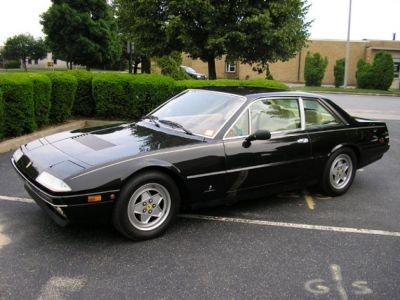 1979 Ferrari 400 I Dimensions, Size & Specs
1979 Ferrari 400 I Dimensions, Size & SpecsMeasurements of the 1979 Ferrari 400 I, engineered for optimal performance and comfort
| Dimensions | |
|---|---|
| Length: | 4810 mm189.4 in15.8 ft |
| Width: | 1798 mm70.8 in5.9 ft |
| Height: | 1314 mm51.7 in4.3 ft |
| Ground Clearance: | 140 mm5.5 in0.5 ft |
| Trunk Capacity: | 486 liter17.2 cu ft |
| Weight Specifications | |
| Curb Weight: | 1830-1900 kg4034-4189 lbs |
| Tire Specifications | |
| Rims Sizes: | 15-inch rims:
|
| Tire Size: |
|
The Ferrari 400 I, produced between 1979 and 1985, is a classic grand tourer coupe that combines elegant design with substantial size and performance. This generation of the Ferrari 400 measures 4810 mm (189.4 inches) in length, 1798 mm (70.8 inches) in width, and stands 1314 mm (51.7 inches) tall, making it a sizeable vehicle in its class designed to offer both comfort and style. Weighing between 1830 and 1900 kilograms (4036 to 4189 pounds), the 400 I provides a solid and stable driving experience, underscored by its robust build quality. Its ground clearance is set at 140 mm (5.5 inches), which balances sporty road handling with practicality for typical road conditions. The car rides on 15-inch rims sized 15,7J x 15, fitted with 215/70 R15 tires that complement its grand touring capabilities. A notable practical feature is its spacious luggage capacity of 486 liters (17.2 cubic feet), making it well-suited for longer trips or weekend getaways. Overall, the Ferrari 400 I represents a harmonious blend of Italian craftsmanship, generous dimensions, and functionality, standing out as a luxurious and enduring icon from the late 1970s through the mid-1980s.
Discover the standout features that make the 1979 Ferrari 400 I a leader in its class
Have a question? Please check our knowledgebase first.
The Ferrari 400 I from 1979 to 1985 measures 4810 mm (about 189.4 inches) in length, 1798 mm (approximately 70.8 inches) in width, and 1314 mm (around 51.7 inches) in height. These dimensions reflect the car's classic grand tourer proportions, combining a long hood and elegant coupe profile with a relatively modest height to enhance aerodynamics and sporty aesthetics. Its size places it firmly in the grand tourer segment, balancing interior space and road presence without being overly large.
The curb weight of the Ferrari 400 I ranges between 1830 kg and 1900 kg (approximately 4036 to 4190 pounds). This weight reflects the solid construction typical of grand tourers of its era, influenced by the large V12 engine and luxury features. While heavier than more compact sports cars, this weight contributes to the car's stability and smooth ride at high speeds. The weight balance, combined with the front-engine layout, provides a blend of comfort and capable handling, suited for long-distance cruising with spirited performance.
The Ferrari 400 I has a ground clearance of 140 mm (about 5.5 inches), which is typical for a grand tourer designed primarily for paved road use. This clearance provides a reasonable compromise between sporty handling and everyday usability, allowing the vehicle to clear speed bumps and uneven road surfaces without sacrificing stability. However, drivers should still exercise caution on very rough terrain or steep driveways, as the low clearance can be susceptible to scraping the underbody.
The Ferrari 400 I features 15-inch rims with a width of 7J (15x7J), paired with 215/70 R15 tires. This tire size provides a good balance of grip and comfort, supporting the grand touring nature of the vehicle. The relatively tall tire sidewall helps absorb road imperfections, complementing the suspension setup for a smoother ride, while the tire width contributes to sufficient traction during spirited driving. These specifications were typical during the late 1970s and early 1980s but still deliver a classic driving experience consistent with Ferrari's performance standards.
The Ferrari 400 I offers a luggage capacity of 486 liters (approximately 17.2 cubic feet). This is quite generous for a grand touring coupe and makes the vehicle practical for long trips where passengers may need to carry several pieces of luggage. The ample trunk space reflects the car’s design focus not just on performance but also on comfort and usability. This capacity allows the 400 I to serve as a capable GT car, able to transport both occupants and their belongings in style without compromising on luggage room.
Yes, the Ferrari 400 I fits comfortably within a standard residential garage. With a width of 1798 mm (70.8 inches) and height of 1314 mm (51.7 inches), it’s narrower and lower than many modern vehicles, allowing easy entry and exit from typical garage spaces, which usually measure around 2.4 meters (94.5 inches) wide and over 2 meters (78.7 inches) high. The length of 4810 mm (189.4 inches) is also within the limits of standard garage depth, so owners generally experience no issues parking their 400 I in home garages.
Compared to its predecessor, the Ferrari 365 GT 2+2, the Ferrari 400 I saw a slight increase in dimensions, particularly in length and width, which enhanced interior space and overall road presence. The 400 I measures 4810 mm in length and 1798 mm in width, which is marginally longer and wider than the 365 GT 2+2, typically around 4620 mm long and 1780 mm wide. This increase allows for improved passenger comfort and a more modern aesthetic, while retaining similar height and ground clearance, maintaining grand tourer proportions with improvements in usability.
The Ferrari 400 I is competitive in size when compared to contemporary grand tourers from other brands like Maserati, Jaguar, and Aston Martin during the late 1970s and early 1980s. Its length of 4810 mm and width of 1798 mm put it within the typical range for luxury GT coupes, offering a balance of interior space and manageable exterior dimensions. For instance, rival models like the Jaguar XJ-S and Maserati Quattroporte had similar dimensions but differed in design emphasis—Ferrari focused more on performance-oriented grand touring with a sporty edge, while others sometimes leaned more towards luxury comfort.
The Ferrari 400 I features a front-mounted V12 engine paired with a 2+2 coupe body style, which influenced its extended length and relatively compact height. The longer wheelbase compared to its predecessor provided more rear passenger space without compromising on sporty handling. The use of relatively wide 215/70 R15 tires helped in maintaining a comfortable ride and better road grip. Additionally, the relatively low ground clearance of 140 mm helped improve aerodynamic efficiency and stability at high speeds, all while maintaining practicality with a generous 486-liter luggage capacity.
Given its size, weight (ranging between 1830 and 1900 kg), and grand touring design, the Ferrari 400 I offers a balanced driving experience that blends comfort and performance. The front-engine V12 powertrain combined with a fairly heavy curb weight means the car excels at smooth, stable, high-speed cruising rather than aggressive, track-style handling. Its dimensions allow for comfortable accommodations for four passengers, making it suitable for luxurious longer drives. While it is not as nimble as smaller sports cars due to its size and weight, its ride quality and engine delivery ensure a refined and exhilarating grand tourer experience.
Discover similar sized cars.

| Production: | 1985-1988 |
|---|---|
| Model Year: | 1985 |
| Length: | 4810 mm189.4 in |
| Width: | 1798 mm70.8 in |
| Height: | 1314 mm51.7 in |

| Production: | 2007-2010 |
|---|---|
| Model Year: | 2008 |
| Length: | 4871 mm191.8 in |
| Width: | 2043 mm80.4 in |
| Height: | 1372 mm54.0 in |

| Production: | 1990-1995 |
|---|---|
| Model Year: | 1990 |
| Length: | 4815 mm189.6 in |
| Width: | 1795 mm70.7 in |
| Height: | 1305 mm51.4 in |
